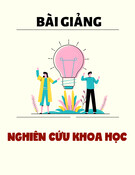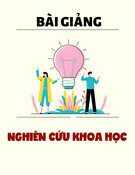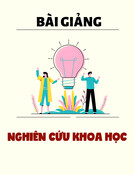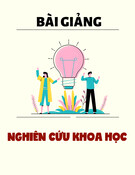
61
https://doi.org/10.52111/qnjs.2025.19205
Tạp chí Khoa học Trường Đại học Quy Nhơn, 2025, 19(2), 61-74
Sự thay đổi vai trò của giảng viên
trong môi trường giáo dục số
Nguyễn Lê H*
Khoa Khoa học Xã hội v Nhân văn, Trường Đại học Quy Nhơn, Việt Nam
Ngy nhận bi: 10/11/2024; Ngy sửa bi: 30/12/2024;
Ngy nhận đăng: 02/01/2025; Ngy xuất bản: 28/04/2025
TÓM TẮT
Bài báo tập trung phân tích sự thay đổi vai trò của giảng viên trong môi trường giáo dục số dưới tác động
của công nghệ và các xu hướng mới trong giáo dục. Vai trò của giảng viên không còn ch là người truyền đạt kiến
thức mà đã mở rộng thành người hướng dẫn, cố vấn, thiết kế nội dung số và hỗ trợ kỹ thuật. Bài viết sử dụng
phương pháp phân tích lý thuyết, mô tả, tổng quan tài liệu từ các nghiên cứu trước đây để làm rõ các yếu tố tác
động, kỹ năng cần thiết và thách thức mà giảng viên đối mặt. Đồng thời, nghiên cứu áp dụng phương pháp phân
tích tình huống để đánh giá thực trạng vai trò giảng viên trong bối cảnh giáo dục số tại Việt Nam. Qua đó, bài viết
đề xuất các giải pháp như phát triển kỹ năng công nghệ, thay đổi phương pháp giảng dạy, tăng cường vai trò cố
vấn, xây dựng môi trường hợp tác và cải thiện môi trường chính sách nhằm hỗ trợ giảng viên thích ứng với yêu
cầu giáo dục thời đại số.
Từ khóa: Vai tr của giảng viên, gio dc s, học trực tuyến, c nhân hóa học tập.
*Tc giả liên hệ chính.
Email: nguyenleha@qnu.edu.vn
TRƯỜNG ĐẠI HỌC QUY NHƠN
KHOA HỌC
TẠP CHÍ

62 Quy Nhon University Journal of Science, 2025, 19(2), 61-74
https://doi.org/10.52111/qnjs.2025.19205
QUY NHON UNIVERSITY
SCIENCE
JOURNAL OF
The changing role of lecturers
in the digital education environment
Nguyen Le Ha*
Department of Social Sciences and Humanities, Quy Nhon University, Vietnam
Received: 10/11/2024; Revised: 30/12/2024;
Accepted: 02/01/2025; Published: 28/04/2025
ABSTRACT
This article focuses on analyzing the evolving role of lecturers in the digital education environment under the
influence of technology and emerging educational trends. The role of lecturers has further expanded beyond being
mere knowledge transmitters to encompass guiding, advising, designing digital content, and providing technical
support. The study employs theoretical analysis, descriptive methods, and a literature review of previous research
to elucidate the influencing factors, required skills, and challenges faced by lecturers. Additionally, it applies a
case analysis method to evaluate the current state of lecturers' roles in the context of digital education in Vietnam.
Based on these findings, the article proposes solutions such as developing technological skills, adapting teaching
methods, enhancing advisory roles, fostering collaborative environments, and improving policy frameworks to
support lecturers in adapting to the demands of education in the digital era.
Keywords: The role of lecturers, digital education, online learning, personalized learning.
*Corresponding author.
Email: nguyenleha@qnu.edu.vn
1. INTRODUCTION
In the era of the Fourth Industrial Revolution,
the rapid development of information and
communication technology has brought profound
changes in all fields, especially in education.
Advances such as artificial intelligence (AI),
big data, machine learning, and online learning
platforms (LMS - Learning Management
System) not only reshape the way knowledge
is delivered but also open up new opportunities
for personalized learning. At the same time, they
demand a strong transformation in the role of
lecturers, shifting from traditional knowledge
transmitters to more multifaceted roles in the
digital environment.
In the traditional education environment,
the lecturer (the teacher) plays a central role
in the teaching and learning process, where
knowledge is transmitted from the teacher to the
students (learners) through one-way methods.
These important roles include:
The knowledge transmitter: The lecturer
is the primary source of knowledge, responsible
for presenting the lesson content in a clear and
logical manner. The "knowledge transmission"
model has been widely applied in traditional
classrooms. According to Freire, this is a method
where the lecturer plays the role of the "sender,"
while the learner is seen as a "container"
receiving the information.1
The advisor and guide: In addition to
teaching, the lecturer also takes on the role of an
advisor, helping learners navigate their learning
paths and solve problems during the learning

Quy Nhon University Journal of Science, 2025, 19(2), 61-74 63
https://doi.org/10.52111/qnjs.2025.19205
QUY NHON UNIVERSITY
SCIENCE
JOURNAL OF
process. Knowles emphasizes that, in adult
education, the lecturer is not only a provider
of information but also a supporter who helps
learners discover knowledge on their own.2
The evaluator: Another important role of
the lecturer is to assess the learning outcomes of
students through tests, assignments, and other
forms of examinations. According to Biggs
and Tang, these assessment tools are designed
to measure the students' level of knowledge
acquisition and their ability to apply it in real-
world situations.3
The shaper of values and thinking: In the
traditional education environment, lecturers not
only transmit knowledge but also contribute to
shaping the values, ethics, and critical thinking of
learners. Dewey argued that education is not just
about receiving information but also a process
of character formation through experience and
interaction.4
However, with the widespread use of
digital technology, learners can now easily
access a wealth of knowledge from various
sources. This not only changes the motivation for
learning but also presents significant challenges
for lecturers in redefining their roles. Instead
of merely transmitting knowledge, lecturers
must become designers of learning experiences,
advisors supporting personalized learning, and
companions in helping students develop critical
thinking and self-learning skills.
Many studies worldwide, such as those
by Laurillard and Bates,5,6 have emphasized
that the role of lecturers in digital education
is not merely about using technology, but also
about creatively integrating it into teaching.
However, these changes come with significant
challenges, including the pressure to learn new
technologies, manage increased workloads,
and the lack of direct interaction with learners.
Specifically, in Vietnam, this transition is taking
place in the context of an education system
still faces numerous limitations regarding
infrastructure, policies, and the training of
lecturers' technological skills.
With these changes and challenges, this
article aims to study and analyze the following
issues:
(1) The changing role of lecturers in the
digital education environment.
(2) The necessary skills to adapt to the
new demands.
(3) Solutions to support lecturers in
enhancing teaching effectiveness in the context
of digitalization.
Through the method of document analysis
and theoretical synthesis, the article not only
provides a comprehensive view of the lecturer's
new role but also offers practical suggestions to
support them in meeting the increasingly diverse
learning needs of students.
2. RESEARCH METHOD
2.1. Theoretical analysis
This method is used to build the theoretical
foundation for the study, clarifying key concepts
such as the role of lecturers in traditional and
digital education. The research focuses on
digital education theories and modern pedagogy
from scholars such as Bates and Collins &
Halverson.6,7 At the same time, the article
analyzes the relationships between influencing
factors, including technology, learners, and
educational policies, in order to identify trends
in the changing roles of lecturers in the context
of digitalization.
The study collects and analyzes scientific
literature from reputable domestic and
international sources, including monographs,
scientific articles, and reports from educational
organizations such as UNESCO. The selected
literature is related to the changing role of
lecturers, the necessary skills in digital education,
and the challenges lecturers face. The literature
review method not only helps identify research
gaps but also provides a basis for comparison
with the current situation in Vietnam.

64 Quy Nhon University Journal of Science, 2025, 19(2), 61-74
https://doi.org/10.52111/qnjs.2025.19205
QUY NHON UNIVERSITY
SCIENCE
JOURNAL OF
2.2. Analysis of practical cases
The study applies the case study analysis method
to assess the current status of the lecturer's role
in digital education in Vietnam and in the world,
under the influence of technology and factors
such as the COVID-19 pandemic. Through
this method of analysis, the article analyzes the
main challenges faced by lecturers, such as the
pressure to master technology, manage online
classrooms, and personalize learning.
2.3. Descriptive method
- Describing the role of lecturers in
traditional education: Lecturers primarily play
the role of one-way knowledge transmitters,
teaching in physical spaces, and assessing
learning outcomes in standardized examinations.
- Describing the role of lecturers in digital
education: The role of lecturers is expanded and
more flexible, including being digital content
designers, learning guides and mentors, learning
process managers, and technical support
providers.
Based on the description, the study
highlights the shift from the role of knowledge
transmission to support and accompaniment,
emphasizing lecturers' adaptation to technology
and new learning demands.
Within the scope of the study, this article
is theoretical and applied in nature. It does not
employ investigative or experimental methods
but primarily relies on document analysis and
practical synthesis.
3. CONTENT
3.1. The traditional role of lecturers
3.1.1. The concept of traditional education
Traditional education has existed for many
generations. The concept of traditional education
is approached as follows:
- According to H. V. Pham, traditional
education is understood as "an educational system
based on long-established values and methods,
which not only focuses on the transmission of
knowledge but also emphasizes the development
of ethical values, discipline, and responsibility in
learners".8
- L. T. Nguyen and M. T. Nguyen argue that
traditional education is "focused on educational
methods passed down through generations, often
involving teacher-centered approaches".9
From the above-mentioned studies, the
concept of traditional education is understood
as "a form of direct education in the classroom,
where the teacher plays the role of the main
source of knowledge, and the learner acquires
information through listening and note-taking.
This model involves direct interaction between
the teacher and the learner, with which most
teaching methods rely on one-way transmission
of information from the teacher to the learner.
The learning environment is characterized by
high discipline and structure".
Some key characteristics of traditional
education include: teacher-centered teaching
methods, passive learning, a standardized
curriculum, assessment through examinations,
and the classroom environment taking place in
a physical space.
3.1.2. Factors influencing the transition from
traditional education to digital education
Traditional education at universities has existed
for a long time with teaching methods such as
direct lectures and a lecturer-centered approach.
However, in recent years, in the context of
education undergoing significant transformation
due to the impact of various factors, including
technological development, learners' needs,
and demands from the environment and labor
market, this shift has become more pronounced.
- The Development of Technology: Digital
technology is a leading factor driving change in
education. Online learning platforms, technology
applications in the classroom such as Moodle,10,11
Google Classroom, and LMS systems have
transformed lecturers' teaching methods and
learners' approach.11,12 The application of
information technology in teaching has resulted
in higher effectiveness, providing flexible

Quy Nhon University Journal of Science, 2025, 19(2), 61-74 65
https://doi.org/10.52111/qnjs.2025.19205
QUY NHON UNIVERSITY
SCIENCE
JOURNAL OF
learning opportunities for students. Therefore,
technology not only expands access to education
but also changes the nature of interaction
between lecturers and learners.
- The development of AI, big data, and
machine learning has contributed to optimizing
personalized teaching methods and measuring
learning outcomes.13 This is an important trend
that traditional education must adapt to in order
to ensure the delivery of knowledge relevant to
the digital age.
- The Needs and Psychology of Learners:
In the current stage, learners demand greater
flexibility in accessing knowledge. The majority
of learners, especially younger generations
such as Generation Z (those born between the
mid-1990s and the early 2010s), desire more
control over their learning process. They seek
diverse, highly interactive learning methods,
and particularly those that match their individual
learning pace. Therefore, in the current trend, the
shift to open and distance learning formats has
helped meet the learning needs of students while
also improving the quality and effectiveness of
education.14
According to UNESCO in 2022, the
adoption of technology in education has
significantly increased over the past decade,
especially during and after the COVID-19
pandemic. This has required lecturers to adapt
to new teaching methods to meet the demands
of remote and digital learning. In this context,
many lecturers need to enhance their digital
skills and adjust their teaching approaches,
although challenges remain in ensuring equitable
access for all learners. Moreover, governments
and educational systems worldwide have been
striving to use technology to improve the quality
and effectiveness of education, but significant
challenges remain in terms of infrastructure and
training for lecturers.
- Pressure from the labor market and
society: The modern labor market is shifting
towards a demand for new skills such as
critical thinking, problem-solving ability, and
communication skills. According to the 2020
World Economic Forum report, by 2025, around
85 million jobs may be replaced by technology,
while many new jobs will require skills that
traditional education has not fully prepared
for. In this context, lecturers need to meet the
demands of society. Integrating project-based,
hands-on, and collaborative learning methods
into training programs will help learners develop
the essential soft skills.15 Higher education in
Vietnam is undergoing significant adjustments
to keep up with this trend.
- The Impact of the COVID-19 Pandemic:
The COVID-19 pandemic has been considered
as a catalyst in driving change in traditional
education. Many universities worldwide were
forced to shift to online teaching in a short period,
and the pandemic highlighted the weaknesses of
traditional education in responding to unexpected
situations, while accelerating the process of
digitalization in education.16
Currently, we can see that traditional
education is facing challenges in the context
of the rapid development of technology and
changes in societal needs. Factors such as
technology, learner needs, demands from the
labor market, and the COVID-19 pandemic have
all contributed to driving this significant change.
Educational institutions need to be ready to
change teaching models and training methods to
align with the new context, while also ensuring
that learners can develop comprehensively in
terms of knowledge and skills.
3.2. The development of digital education
3.2.1. The concept of digital education
Digital education is becoming increasingly
important in the context of rapid advancements
in information technology. The concept of digital
education can be approached from the following
perspectives:
T. Anderson argues that digital education
is the use of digital technology in teaching and
learning.17

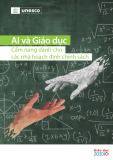
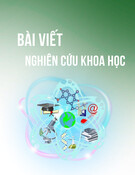
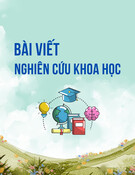
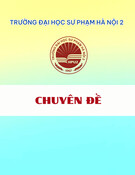
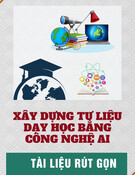

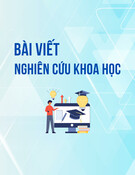





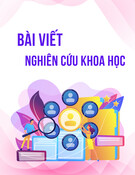
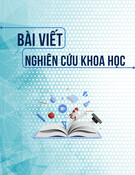
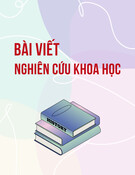
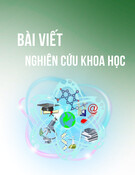

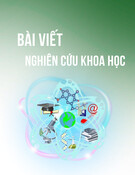
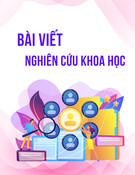
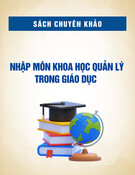
![Định hướng giáo dục STEM trong trường trung học: Tài liệu [chuẩn/mới nhất]](https://cdn.tailieu.vn/images/document/thumbnail/2025/20251124/dbui65015@gmail.com/135x160/25561764038505.jpg)
